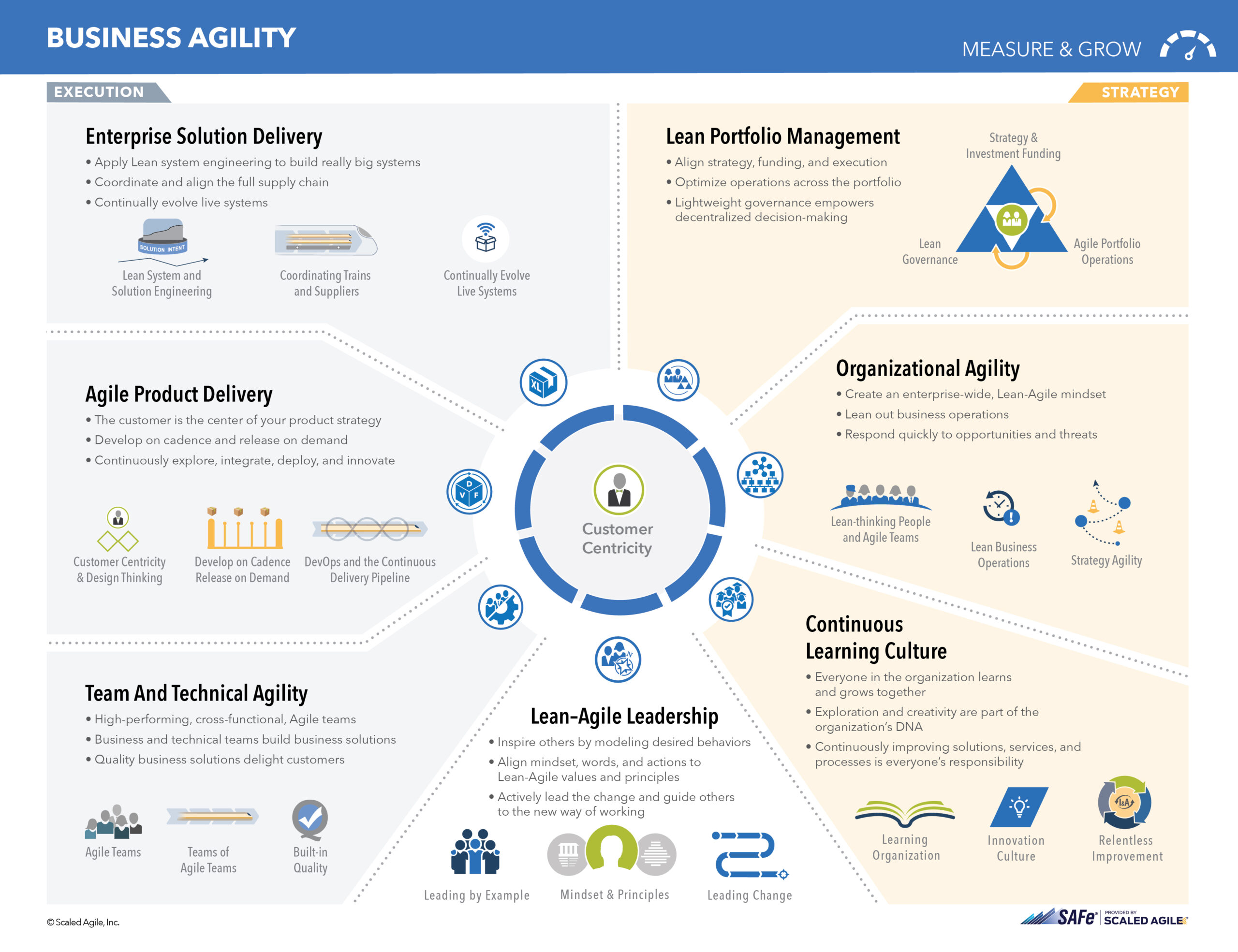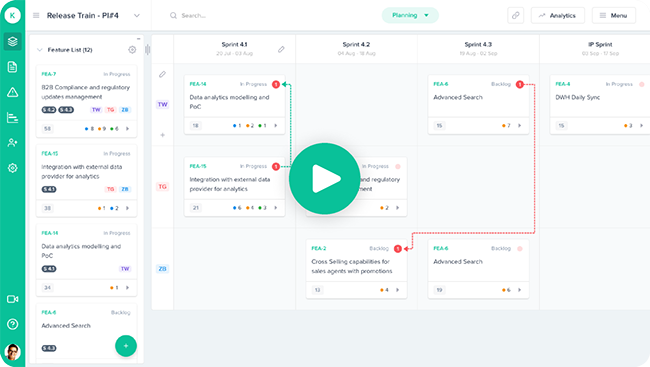In today’s highly competitive world, organizations are driven by technology and are becoming very innovative in achieving their goals and to eventually stay ahead. Starting off with this New Year January 2020, SAFe released its upgrade, “SAFe 5.0” which entirely focuses on “Business Agility” and addresses how to manage your growth and success in this fierce competition.
The new SAFe 5.0 has seven new competencies of the Lean Enterprise that are geared towards enhancing and growing Business Agility. These seven competencies are categorized into Execution Related Competencies and Strategy Development with the latter having two new competencies added and few of them restructured. These abilities are vital for assessing Business Agility. The picture below is also known as Measure and Grow introduced in this new release which helps in measuring Business Agility.

This release also emphasizes on becoming more customer-centric that involves concentrating on understanding the market and the customer to create a better product and design strategy. Updates have been made to the Roadmap, House of Lean and to the SAFe principles that we will discuss at the end of this article. The competencies of the new release are described below.
Strategy Development
- Lean Portfolio Management: This is a crucial element of SAFe. It dictates the effective management of budgets and formulating approaches for building strategy and the vision for the Value Streams. Activities like Strategy and Investment Funding, Agile Portfolio Operations and Lean Governance are important aspects of Lean Portfolio Management. These features help in aligning the portfolio to attain business targets while coordinating and aligning the program execution. At the same time, the budgets are effectively utilized and the entire operation is audited.
- Organizational Agility (New): An important concept that describes how Lean thinking and Agile teams can be collated together to improve strategies and processes. The three defining elements of this new feature are:
- Lean-Thinking People and Agile Teams
- Lean Business Operations: Application of Lean Principles to support processes
- Strategy Agility: This concept focuses on monitoring the changes in the market and then adjusting the strategy accordingly.
- Continuous Learning Culture (New): Individuals always need to be on the hunt for learning new things. They have to relentlessly improve and always be welcome to new ideas, knowledge, performance, and innovation. There are three aspects of this new competency:
- Learning Organization: The people need to learn new things and grow so they can benefit themselves and the entire organization.
- Innovation Culture: The need for exploring and finding smarter ways to solve the problem.
- Relentless Improvement: Improving your processes and products every step of the product’s development.
Execution Related Competencies
- Enterprise Solution Delivery (Previously known as Business Solutions and Lean Systems Engineering): Building Lean Systems is all about applying Lean-Agile Principles and practices to the specification, development, and deployment of software applications. The Agile Release Trains are coordinated and in sync to the Vision and Roadmap. Finally, large systems have to be created in a way so that they support continuous delivery.
- Agile Product Delivery (Previously known as DevOps and Release on Demand): Focusing on implementing DevOps and a continuous delivery pipeline to release on demand have been improved. Delivering quick allows enterprises to meet and adjust according to changing demands. Two new capabilities have been added which are:
– Customer Centricity and Design Thinking: When designing the product, understanding the customer standpoint is very important. The design has to be crafted in a way that is feasible, sustainable and satisfies their requirements.
– Develop on Cadence: Release on Demand: Understanding how cadence assists in managing the varying changes in product development are paramount. - Team and Technical Agility: Team agility can be thought of as the engine of driving SAFe. It is when the teams are aware of Agile principles and practices and perform with high speed. Teams perform well in an Agile Release Train that are focused on achieving their objectives. These teams work to create high quality and thoroughly designed technical solutions that fulfill business needs.
- Lean-Agile Leadership: This has always been the focal point of SAFe. Leaders that are trained in being effective Lean-Agile Leaders and who can educate their teams are pertinent in SAFe. These leaders need to be well versed in the SAFe Core Values and possess the quintessential Agile Mindset. They need to understand the need for continuous growth in an organization and operational excellence. Ultimately they are responsible for the success of their teams.
Updates to the Implementation Roadmap
Lean Portfolio Management and the Agile Product and Solution Management are added to the Implementation Roadmap. Lean Portfolio Management needs to be involved for Training Executives, Managers and Agile Product and Solution Management has to coach the ART for their execution of the Program Increment.
Updates to the House of Lean
The House of Lean consists of four pillars and to each of them, these are the new changes made:
- Respect for People and Culture
- Generative Culture
- Flow
- Move from Projects to Products
- Innovation
- Innovative People
- Experimentation and Feedback
- Innovation Riptides
- Relentless Improvement
- Problem Solving Culture
- Base Improvements on Facts
Updates to the SAFe Principles
A new principle has been added to the existing SAFe Principles which is quoted as “Organize around Value”. This essentially means that the enterprises need to be aligned and committed to attaining value. The teams need to be organized and work together towards delivering quality with minimum handoffs.
Unleash Your Organization’s True Potential to Scale Agile with Kendis
Kendis offers an all-inclusive solution to planning, tracking and managing your Program Increment and dependencies between distributed teams. It works on top of JIRA and other agile tools, your teams can keep on working with their existing JIRA boards and program level and above is planned and managed at Kendis.
Try out 10 days free trial or book a demo with our product expert.
Kendis is a digital solution for PI, Tribe and Big room Planning that works on top of Jira and Azure Boards.










